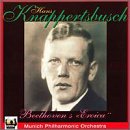| All Artists: Beethoven, Munich Phil Orch, Knappertsbusch Title: Symphony 3: Eroica 1953 Members Wishing: 0 Total Copies: 0 Label: Tahra France Release Date: 4/28/1998 Genre: Classical Styles: Historical Periods, Classical (c.1770-1830), Symphonies Number of Discs: 1 SwapaCD Credits: 1 UPCs: 3504129029418, 672911229421 |
Search - Beethoven, Munich Phil Orch, Knappertsbusch :: Symphony 3: Eroica 1953
 | Beethoven, Munich Phil Orch, Knappertsbusch Symphony 3: Eroica 1953 Genre: Classical
|
Larger Image |
CD Details |
CD ReviewsA Warm "Eroica" From Munich Thomas F. Bertonneau | Oswego, NY United States | 12/18/2000 (4 out of 5 stars) "Hans Knappertsbusch (1888-1965), or "Kna," led the life of a journeyman conductor, most closely associated with Munich, during the first half of the twentieth century. Like his contemporaries, Wilhelm Furtwängler and Hermann Abendroth, he concentrated on a rather cirumscribed repertory, mostly the three B's, plus Wagner, Bruckner, Schubert, and a handful of Romantic composers. Collectors remember him today as a Brucknerian above all else - and his Berlin Philharmonic performances of Symphonies nos. 4, 7, 8, and 9 put him in the first rank of the "Antonistas" of his day. Mostly, "Kna" shows up at the head of regional orchestras, in Munich, Hamburg, Bremen, or at the Bayreuth Festival, where he conducted memorable "Meistersingers," "Parsifals," and "Rings." His Beethoven, while not so much at the center of his conductorial regimen as in the case of Furtwängler, nevertheless always exerts some claim on attention, as in his traversals of the "Eroica," the 17 December 1953 performance reissued by Tahra being one of four that exist on record. Comparisons can shed light on the characteristics of "Kna's" Beethovenian style. His timings in the movements and overall resemble Furtwängler's, and his interpretation matches Furtwängler's in "bigness" without, however, incorporating the demonic quality; "Kna's" "Eroica" offers a monumental rather than a tragic conception. Set this Munich "Eroica" alongside one of those modern interpetations that proliferate on CD these days, and the comparison brings out other important features in "Kna's" idea. Sir Roger Norrington and his London Classical Players, take the two opening chords quite rapidly, as if they constituted something "hor d'oeuvre" and of no interest; David Zinman and the Zurich Tonhalle, while not quite as hasty, also plunge in. "Kna," by contrast, lets the chords resound warmly, and warmth supplies the mood throughout the movement. "Kna" shapes the architecture of the Funeral March admirably, letting us understand it as a hybrid of rondo and fugue. The closest thing to this in recent terms is Celibidache's performance with the Munich Philharmonic, issued a couple of years ago by EMI. I like the sonics of this recording, very much in the high fidelity monophonic category, tweaked perhaps by Tahra to give it a little extra resonance, but quite convincing. This stands close to being my favorite "Eroica." It is at least on par with Furtwängler's 1952 performance in Berlin, even though it does not reach the degree of intensity of Furtwängler's 1944 performance also in Berlin."
|

 Track Listings (4) - Disc #1
Track Listings (4) - Disc #1